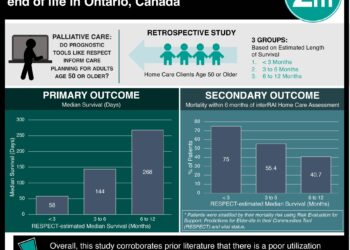Patient demographics associated with fewer hospice visits prior to death
1. According to a retrospective review of hospice patients, certain patient demographics, including black race, failure to thrive diagnosis, nursing home residency, and Sunday deaths, were associated with fewer visits by professional hospice workers in the last two days before death.
2. While difficult to assign causality with this type of study, this study does offer areas in which hospice care could be improved.
Evidence Rating Level: 2 (Good)
Study Rundown: Hospice care aims to ensure patient quality of life and symptom control at the end of life. Additionally, hospice care provides emotional support to family members and patients. Family members have highlighted that in the days immediately before death, it is particularly important to have professional support medical and psychological symptom management. The Medicare hospice benefit program aims to provide these services, however it does not have any mandated minimum number of required visits, so it is unclear whether the needs are met. This study use retrospective Medicare administrative data to examine the visits by hospice professional staff to the dying patient and family in the final two days of the patient’s life.
The frequency of hospice care visits in the last two days of life varied according to race, type of hospice facility, and day of the week the patient died. In particular, black race, failure to thrive diagnosis, nursing home residency, and Sunday deaths, were associated with fewer visits by professional hospice workers in the last two days before death. Strengths of this study included a large, nation-wide cohort, which increased generalizability. Limitations of this study included lack of information on the dying patient’s severity of symptoms and the wishes of the family, which may preclude visits. However, the difference seen on visit frequencies associated with day of death suggests that this may not explain these differences seen across race or hospice facility.
Click to read the study, published today in JAMA Internal Medicine
Relevant Reading: Disparity in hospice utilization by African American patients with cancer
In-Depth [retrospective cohort]: This retrospective cohort study was conducted using Medicare hospice beneficiary administrative data from October 2013 to September 2014, and included all patients who died in that time period who were receiving routine home hospice care. The data was analyzed for the variation in visits received by patients and health care professional, and patient characteristics. Descriptive statistics gathered information on sex, ethnicity, primary diagnosis, residential setting at death, etc. A multivariable logistic model was used to examine descriptors associated with lack of visits by professional staff.
Over 661,000 patients were included in the study and overall 81,478 (12.3%) did not receive professional staff visits in the last two days of life. This varied by state, and ranged from a low of 3.8% in Wisconsin to a high of 19.7% in Alaska. Patient characteristics associated with decreased likelihood of visits were race and diagnosis. Black patients were 1.3 times less likely to have any visits than white patients (95% CI 1.24-1.37). Also, patients with a primary diagnosis of failure to thrive were 1.23 times less likely to have visits two days prior to death (95% CI 1.05-1.45). Hospice program characteristics that were associated with fewer visits included nursing home residency, where patients were 1.74 times less likely to have a visit (95% CI 1.62-1.88). Lastly, patients who died on Sundays were 3.35 times less likely to have visits from professional workers in the two days prior (95% CI 3.17-3.55).
Image: PD
©2016 2 Minute Medicine, Inc. All rights reserved. No works may be reproduced without expressed written consent from 2 Minute Medicine, Inc. Inquire about licensing here. No article should be construed as medical advice and is not intended as such by the authors or by 2 Minute Medicine, Inc.







